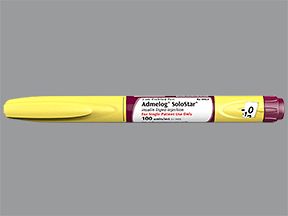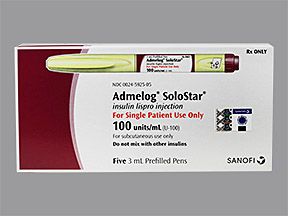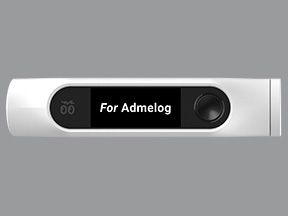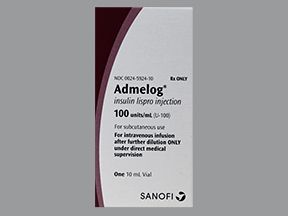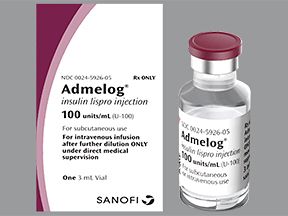Admelog (insulin lispro) is a brand-name prescription medication. The Food and Drug Administration (FDA) has approved it to improve blood sugar levels in:
- adults with type 2 diabetes
- adults and children ages 3 years and older with type 1 diabetes
Admelog contains the active ingredient insulin lispro and belongs to a class of drugs called rapid-acting insulins. Admelog comes as a solution that you self-administer as a subcutaneous injection. A healthcare professional can also administer Admelog as an IV injection.
Admelog is a follow-on
Dosing chart for Admelog vials and SoloStar pens
The manufacturer has not recommended a specific dosage of Admelog to treat diabetes. Your dosage will depend on several factors. See the “Factors affecting dosage” section below for more details.
The following chart summarizes Admelog’s dosage according to the drugs prescribing information. Your doctor will determine the dosage that’s best for you.
| Diabetes type | Recommended Daily Dose | Typical dosing schedule |
| Type 1 | 0.4 units to 1 unit of insulin per kilogram (about 2.2 pounds) per day* | Your daily dose will be divided between meals (either 15 minutes before your meal or right after you’ve eaten) |
| Type 2 | 4 units per day* (but this will depend on your doctor’s recommendation) | Your daily dose will be taken either before your biggest meal of the day or right after you’ve eaten |
* For this use, your dose of Admelog is based on your weight and other types of insulin that you are using.
You can also use Admelog in an insulin pump.
For information about the dosing of Admelog, including the insulin’s strength and how to take the drug, keep reading. For a comprehensive look at Admelog, see this article.
This section describes the typical dosages for Admelog.
Admelog forms
Admelog is a solution that comes in the following forms:
- vials for use with an insulin pump or syringe
- prefilled SoloStar pen
Admelog strength
Admelog comes in one strength: 100 units of insulin per 1 milliliter (mL) of solution (U-100).
Typical dosages
The dosage range for Admelog can vary from person to person. The manufacturer has not recommended a specific dosage of Admelog to manage blood sugar levels. Typically, your doctor will start you on a low dosage for your type of diabetes. Then they’ll adjust it over time to reach the amount that’s right for you. Your doctor will ultimately prescribe the smallest dosage that provides the desired effect.
The following information describes dosages that are commonly used or recommended. However, be sure to take the dosage your doctor prescribes for you. Your doctor will determine the best dosage to fit your needs.
Dosage for type 1 diabetes
The recommended dose of Admelog for type 1 diabetes is 0.4 units to 1.0 unit of insulin per kilogram (kg) per day. Your total insulin dose depends on your weight. For example, if you weigh 80 kg (about 176 pounds) and your doctor prescribes 1 unit/kg/day, your total daily insulin dose will be 80 units.
About half of this total daily insulin dose will be Admelog, which you will give yourself at mealtimes. The other half of your total daily insulin dosage will be intermediate-acting or long-acting insulin.
If you weigh 80 kg (about 176 pounds), a possible Admelog dosage would be about 40 units for the day. You will divide the 40 units between your meals throughout the day. The exact amount of Admelog you take before each meal depends on the amount of carbohydrates you plan to eat. It will also depend on your blood sugar level at the time of the meal.
Talk with your doctor or pharmacist about how to calculate the correct Admelog dosage for each meal.
Dosage for type 2 diabetes
For type 2 diabetes, the typical dose of Admelog is 4 units per day, but this can vary based on your doctor’s recommendation. You will likely take Admelog before your biggest meal of the day or right after you’ve eaten. Some people may also need to take Admelog with other meals. Your doctor will prescribe the dosage that is best for you.
Children’s dosage
The Food and Drug Administration (FDA) has approved Admelog to manage blood sugar levels in children ages 3 years and older with type 1 diabetes. Admelog is not approved to treat type 2 diabetes in children.
The recommended dosage depends on your child’s weight. See the “Dosage for type 1 diabetes” section above for more information.
Long-term treatment
Admelog is meant to be a long-term treatment. If you and your doctor determine that Admelog is safe and effective for you, you’ll likely take it long term.
This section answers some frequently asked questions about Admelog.
Do Admelog vials and SoloStar pens have different dosages?
Admelog vials and the SoloStar pen have the same strength of insulin lispro: 100 units of insulin per 1 milliliter (mL) of solution (U-100). This means your dosage will be the same for each form of Admelog.
The SoloStar pen contains 300 units which is equal to 3 mL. Admelog vials come in 3 mL or 10 mL sizes. You should always use a U-100 syringe with an Admelog vial. You can also use Admelog vials in an insulin pump. Both the Solostar pen and Admelog vials can be used for multiple doses.
If you have questions about the different forms and dosages of Admelog, talk with your doctor.
How can I tell if my Admelog dosage is not working?
If your current Admelog dose is not managing your blood sugar levels, talk with your doctor. This may mean that Admelog is not working for you. Your doctor may need to adjust your dosage.
If you have questions about your dose or how to give yourself your dose of Amelog, talk with your doctor or pharmacist. They can help ensure you are giving yourself the correct dosage of Admelog.
How long does Admelog take to work?
Admelog is a rapid-acting form of insulin that you inject before or immediately after a meal. It starts to work within 5 to 15 minutes after you have injected it. Admelog will continue to work for 4 to 6 hours.
The Admelog dosage your doctor prescribes will depend on several factors. These include:
- the type and severity of the condition you’re using Admelog to treat
- what medications you take, including what other type of insulin you take
- your weight (for type 1 diabetes)
- your blood sugar levels
- if you are feeling sick
- your diet and exercise habits
Other medical conditions you have can also affect your Admelog dosage.
Dosage adjustments
Your doctor could adjust your dosage for any of the following reasons:
- your blood sugar levels are too high or too low
- the other medications you take change, including other insulins
- your diet or exercise habits change
- you are feeling sick
- there is a change in how well your kidneys or liver work
- the severity of your condition changes
Talk with your doctor if you have questions about why your Admelog dose may change.
Admelog comes as a solution that you self-administer as a subcutaneous injection. A healthcare professional can also administer Admelog as an IV injection. Admelog comes as a solution in vials for use with an insulin pump or syringe and a prefilled SoloStar pen.
Subcutaneous injection
Each form of Admelog can be given as a subcutaneous injection. You will inject Admelog into your thigh, buttocks, abdomen, or upper arm 15 minutes before you eat or immediately after a meal.
It’s important to rotate the injection site each time to reduce the risk of pain and other side effects. Do not inject Admelog into skin that has pits or lumps, is thickened, or is scarred, bruised, tender, or damaged.
The SoloStar insulin pen dials in 1-unit increments.
Talk with your doctor or pharmacist about how to use an insulin pen or a syringe. You can also find instructions on the manufacturer’s website and in the package insert.
Intravenous (IV) injection
A healthcare professional can also give you Admelog as an IV injection in a clinic or hospital. Talk with your doctor to see if this is an option for you.
Continuous subcutaneous infusion (insulin pump)
You can also use Admelog vials in an insulin pump. Refer to the pump manufacturer’s instructions for proper use.
It’s important to rotate the pump infusion site according to the manufacturer’s manual to reduce the risk of pain and other issues at the injection site. Do not insert your pump into skin that has pits or lumps, is thickened, or is scarred, bruised, tender, or damaged.
You should change the Admelog vial in your pump a minimum of every 7 days. You should do this even if you have not used all the insulin.
Talk with your doctor or pharmacist for more information about how to use Admelog vials in an insulin pump. Your doctor will determine the best administration rate and time for you.
ACCESSIBLE DRUG LABELS AND CONTAINERSIf you’re having trouble reading your prescription label, talk with your doctor or pharmacist. Some pharmacies offer labels with large print, braille, or a code you scan with a smartphone to convert text to speech. If your local pharmacy doesn’t have these options, your doctor or pharmacist might be able to recommend a pharmacy that does.
You should typically take Admelog 15 minutes before a meal. If you miss a dose, you can check your blood sugar level to see if you should take the missed dose. If it has been more than 2 hours since the meal, wait until your next scheduled dose.
Talk with your doctor or pharmacist if you are unsure if you should take the missed dose of Admelog. If you take insulin too long after the meal, you may have an increased risk of hypoglycemia (low blood sugar).
To help make sure that you don’t miss a dose, try using a medication reminder. This can include setting an alarm or using a timer. You could also download a reminder app on your phone.
If you use more Admelog than your doctor prescribes, you may develop serious side effects.
It’s important that you don’t use more Admelog than your doctor advises.
Symptoms of an overdose
Overdose symptoms of Admelog can include:
- low blood sugar levels
- low potassium levels
If you take more than the recommended amount of Admelog
Call your doctor right away if you believe you’ve taken too much Admelog. Another option is to call the American Association of Poison Control Centers at 800-222-1222 or use its online tool. If you have severe symptoms, immediately call 911 or your local emergency number, or go to the nearest emergency room.
The dosages in this article are typical dosages provided by the American Diabetes Association. If your doctor recommends Admelog for you, they will prescribe the dosage that’s right for you. Always follow the dosage that your doctor prescribes for you.
As with any drug, never change your dosage of Admelog without your doctor’s recommendation. If you have questions about the dosage of Admelog that’s best for you, talk with your doctor.
Besides learning about dosage, you may want other information about Admelog. These additional articles might be helpful to you:
- More about Admelog. For information about other aspects of Admelog, refer to this article.
- Side effects. To learn about the side effects of Admelog, see this article. You can also look at the drug’s prescribing information.
- Drug comparison. Find out how Admelog compares with Humalog and NovoLog.
- Details about diabetes. For details about diabetes, see our diabetes hub and list of related articles.
Disclaimer: Medical News Today has made every effort to make certain that all information is factually correct, comprehensive, and up to date. However, this article should not be used as a substitute for the knowledge and expertise of a licensed healthcare professional. You should always consult your doctor or another healthcare professional before taking any medication. The drug information contained herein is subject to change and is not intended to cover all possible uses, directions, precautions, warnings, drug interactions, allergic reactions, or adverse effects. The absence of warnings or other information for a given drug does not indicate that the drug or drug combination is safe, effective, or appropriate for all patients or all specific uses.

